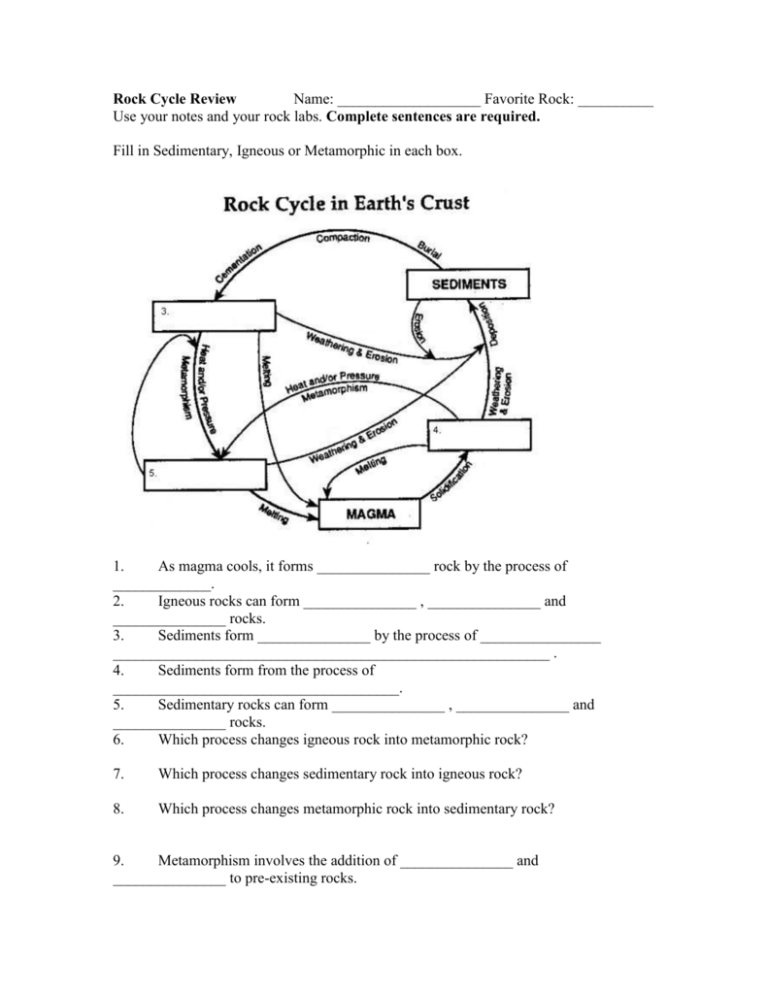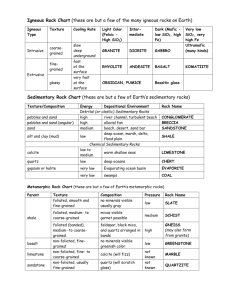rock review
advertisement

Rock Cycle Review Name: ___________________ Favorite Rock: __________ Use your notes and your rock labs. Complete sentences are required. Fill in Sedimentary, Igneous or Metamorphic in each box. 1. As magma cools, it forms _______________ rock by the process of _____________. 2. Igneous rocks can form _______________ , _______________ and _______________ rocks. 3. Sediments form _______________ by the process of ________________ __________________________________________________________ . 4. Sediments form from the process of ______________________________________. 5. Sedimentary rocks can form _______________ , _______________ and _______________ rocks. 6. Which process changes igneous rock into metamorphic rock? 7. Which process changes sedimentary rock into igneous rock? 8. Which process changes metamorphic rock into sedimentary rock? 9. Metamorphism involves the addition of _______________ and _______________ to pre-existing rocks. 10. Compaction & cementation of sediments forms _______________ rocks. 11. Subjecting sedimentary rocks to extreme heat & pressure forms _______________ rocks. 12. Solidification of molten materials forms _______________ rocks. 13. Deposition and burial of sediments forms ___________________ rocks. 14. Deposited sediments may be particles of which types of rock? 15. Heat & Pressure acting on igneous rocks forms ___________________ . 16. Solid magma forms ______________________________ . 17. In order to form magma, what must happen to sedimentary, metamorphic or igneous rocks? 18. For weathering & erosion to occur, what process will the rock usually go through first or at the same time? 19. Can sedimentary rock form directly from metamorphic rock? Explain your answer. 20. All rocks follow the same pathway through the rock cycle is a false statement. Why? 21. How does granite (igneous) change into sandstone (sedimentary)? 22. Define igneous rocks. 23. Define sedimentary rock. 24. Define Metamorphic rock. 25. What does foliated mean? Pathway 1 Between New Zealand and South America, at the bottom of the Pacific Ocean, Molten material from the mantle rises through the crust. As the material comes into contact with the very cold ocean water, it cools quickly to become rock. Over time this rock ever so slowly moves across the ocean floor. About 200 million years later, the rock is pushed downwards. As the rock moves downward, it experiences great amounts of heat and pressure. Pathway 2 Deep underground, a new rock forms as heat and pressure change its crystals and cause its grains to become foliated. Over millions of years, this rock is uplifted to become part of a mountain. Then, layers of rock above the foliated rock wear away, until it becomes exposed at the surface. Destructive forces wear it down, and its fragments are carried away by a river’s swift-flowing water. Eventually, these fragments flow into the ocean. Ocean water carries the rock fragments away from the river and they are deposited on a beach. Over time, more and more sediment is deposited there, until the fragments that came from the foliated rock become cemented into a new rock. Then more and more rock forms above this rock, until the heat and pressure change its crystals and cause its grains to become foliated. 26. Which major group or groups of rocks are involved in the description of Pathway 1? 27. Make a flowchart that describes what occurs in pathway 1 28. 2? Which major group or groups of rocks are involved in the description of pathway 29. Make a flowchart that describes what occurs in Pathway 2. 30. Write a description of another pathway through the rock cycle. In your description, tell how igneous rock changes to metamorphic rock, which then changes to sedimentary rock. 31. Where are intrusive igneous rocks formed? What size of crystals will they have? 32. Where are extrusive igneous rocks formed? What size of crystals will they have? 33. What are clastic rocks? 34. What are foliations in metamorphic rocks? 35. How do chemical sedimentary rocks form? 36. How do organic sedimentary rocks form? 37. Why would you tend to find lots of fossils in sedimentary rocks? Why not in other rocks? Plate Tectonics: 38. Identify the three main types of plate boundaries and the characteristic geological formations found at each: 39. What did Alfred Wegener use as evidence for his theory that the continents were once one giant land mass? 40. What did Wegener call this giant land mass? 41. Identify the layers of the Earth:







